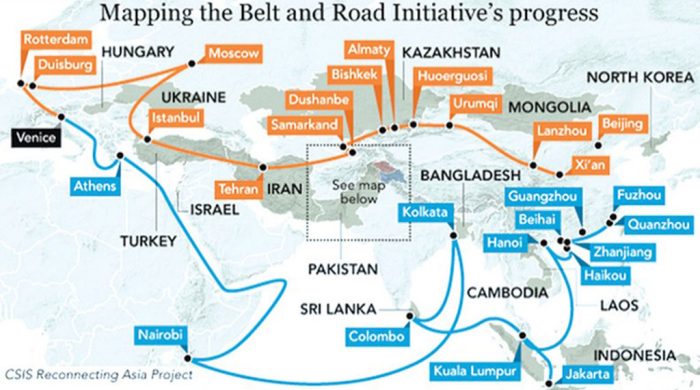How the oil industry made us doubt climate change

- Update Time : Sunday, September 27, 2020
- 154 Time View

As climate change becomes a focus of the US election, energy companies stand accused of trying to downplay their contribution to global warming.
In June, Minnesota’s Attorney General sued ExxonMobil, among others, for launching a “campaign of deception” which deliberately tried to undermine the science supporting global warming.
So what’s behind these claims? And what links them to how the tobacco industry tried to dismiss the harms of smoking decades earlier?
To understand what’s happening today, we need to go back nearly 40 years.
Marty Hoffert leaned closer to his computer screen. He couldn’t quite believe what he was seeing. It was 1981, and he was working in an area of science considered niche.
“We were just a group of geeks with some great computers,” he says now, recalling that moment.
But his findings were alarming.
“I created a model that showed the Earth would be warming very significantly. And the warming would introduce climatic changes that would be unprecedented in human history. That blew my mind.”
Marty Hoffert was one of the first scientists to create a model which predicted the effects of man-made climate change. And he did so while working for Exxon, one of the world’s largest oil companies, which would later merge with another, Mobil.
At the time Exxon was spending millions of dollars on ground-breaking research. It wanted to lead the charge as scientists grappled with the emerging understanding that the warming planet could cause the climate to change in ways that could make life pretty difficult for humans.
Hoffert shared his predictions with his managers, showing them what might happen if we continued burning fossil fuels in our cars, trucks and planes.
But he noticed a clash between Exxon’s own findings, and public statements made by company bosses, such as the then chief executive Lee Raymond, who said that “currently, the scientific evidence is inconclusive as to whether human activities are having a significant effect on the global climate”.
“They were saying things that were contradicting their own world-class research groups,” said Hoffert.
Angry, he left Exxon, and went on to become a leading academic in the field.
“What they did was immoral. They spread doubt about the dangers of climate change when their own researchers were confirming how serious a threat it was.”
So what changed? The record-breaking hot summer of 1988 was key. Big news in America, it gave extra weight to warnings from Nasa scientist Dr Jim Hansen that “the greenhouse effect has been detected, and is changing our climate now”.
Political leaders took notice. Then UK Prime Minister Margaret Thatcher acknowledged the great new global threat: “The environmental challenge which confronts the whole world demands an equivalent response from the whole world.”
In 1989, Exxon’s strategy chief Duane Levine drew up a confidential presentation for the company’s board, one of thousands of documents in the company’s archive which were later donated to The University of Texas at Austin.
Levine’s presentation is an important document, often cited by researchers investigating Exxon’s record on climate change science.
“We’re starting to hear the inevitable call for action,” it said, which risked what it called “irreversible and costly draconian steps”.
“More rational responses will require efforts to extend the science and increase emphasis on costs and political realities.”
How they made us doubt everything investigates how some of the world’s most powerful interests made us doubt the connection between smoking and cancer, and how the same tactics were used to make us doubt climate change.
Kert Davies has scoured through Exxon’s archive. He used to work as a research director at the environmental pressure group Greenpeace, where he looked into corporate opposition to climate change. This inspired him to set up The Climate Investigations Centre. He explains why this Exxon presentation mattered:
“They are worried the public will take this on, and enact radical changes in the way we use energy and affect their business, that’s the bottom line.”
He says this fear can also be seen in another document from the archive that sets out the so-called “Exxon position”, which was to “emphasise the uncertainty” regarding climate change.
Researchers argue this was just the start of a decades-long campaign to shape public opinion and to spread doubt about climate change.
In June 2020, the General Attorney of Minnesota Keith Ellison sued ExxonMobil, the American Petroleum Institute (API) and Koch Industries for misleading the public over climate change. The lawsuit claims that “previously unknown internal documents confirm that the defendant well understood the devastating effects that their products would cause to the climate”.
It says that despite this knowledge, the industry “engaged in a public-relations campaign that was not only false, but also highly effective,” which served to “deliberately [undermine] the science” of climate change.
The accusations against Exxon and others – which the company has called “baseless and without merit” – build on years of painstaking research by people like Kert Davies and Naomi Oreskes, professor of the history of science at Harvard University and co-author of Merchants of Doubt.
“Rather than accept the scientific evidence, they made the decision to fight the facts,” she said.
But this isn’t just about Exxon’s past actions. In the same year as the Levine presentation, 1989, many energy companies and fossil fuel dependent industries came together to form the Global Climate Coalition, which aggressively lobbied US politicians and media.
Then in 1991, the trade body that represents electrical companies in the US, the Edison Electric Institute, created a campaign called the Information Council for the Environment (ICE) which aimed to “Reposition global warming as theory (not fact)”. Some details of the campaign were leaked to the New York Times.
“They ran advertising campaigns designed to undermine public support, cherry picking the data to say, ‘Well if the world is warming up, why is Kentucky getting colder?’ They asked rhetorical questions designed to create confusion, to create doubt,” argued Naomi Oreskes.
The ICE campaign identified two groups which would be most susceptible to its messaging. The first was “older, lesser educated males from larger households who are not typically information seekers”.
The second group was “younger, low-income women,” who could be targeted with bespoke adverts which would liken those who talked about climate change to a hysterical doom-saying cartoon chicken.
The Edison Electric Institute didn’t respond to questions about ICE, but told the BBC that its members are “leading a clean energy transformation, and are united in their commitment to get the energy they provide as clean as they can, as fast as they can”.
But back in the 1990 there were many campaigns like this.
“Unless ‘climate change’ becomes a non-issue,” says another, leaked to the New York Times in 1997, “there may be no moment when we can declare victory”.
To achieve victory, the industry planned to “identify, recruit and train a team of five independent scientists to participate in media outreach”.
This important tactic assumed the public would be suspicious if oil industry executives dismissed climate change, but might trust the views of seemingly independent scientists.
These would be put forward to take part in debates on TV, potentially confusing a general audience who would see opposing scientists in white coats arguing about complex technical details without knowing who to believe.
The problem was, sometimes these “white coats” weren’t truly independent. Some climate sceptic researchers were taking money from the oil industry.
Drexel University emeritus professor Bob Brulle studied the funding for the climate change “counter movement”. He identified 91 institutions which he says either denied or downplayed the risks of climate change, including the Cato Institute and the now-defunct George C Marshall Institute.
He found that between 2003 and 2007, ExxonMobil gave $7.2m (£5.6m) to such bodies, while between 2008 and 2010, the American Petroleum Institute trade body (API) donated just under $4m (£3m).
In its 2007 Corporate Citizenship Report, ExxonMobil said it would stop funding such groups in 2008.
Of course many researchers would argue such money didn’t influence their climate contrarian work. It seems some may have been motivated by something else.
Most of the organisations opposing or denying climate change science were right-wing think tanks, who tended to be passionately anti-regulation.
These groups made convenient allies for the oil industry, as they would argue against action on climate change on ideological grounds.
Jerry Taylor spent 23 years with the Cato Institute – one of those right wing think tanks – latterly as vice president. Before he left in 2014, he would regularly appear on TV and radio, insisting that the science of climate change was uncertain and there was no need to act. Now, he realises his arguments were based on a misinterpretation of the science, and he regrets the impact he’s had on the debate.
“For 25 years, climate sceptics like me made it a core matter of ideological identity that if you believe in climate change, then you are by definition a socialist. That is what climate sceptics have done.”
The BBC asked the Cato Institute about its work on climate change, but it did not respond.
This ideological divide has had far-reaching consequences. Polls conducted in May 2020 showed that just 22% of Americans who vote Republican believed climate change is man-made, compared with 72% of Democrats.
Unfortunately many of the “expert scientists” quoted by journalists to try to offer balance in their coverage of climate change were – like Jerry Taylor – making arguments based on their beliefs rather than relevant research.
“Usually these people have some scientific credentials, but they’re not actually experts in climate science,” says Harvard historian Naomi Oreskes.
She began digging into the background of leading climate sceptics, including Fred Seitz, a nuclear physicist and former president of the US National Academy of Sciences. She found he was deeply anti-communist, believing any government intervention in the marketplace “would put us on the slippery slope to socialism”.
She also discovered that he had been active in the debates around smoking in the 1980s.
“That was a Eureka moment. We realised this was not a scientific debate. A person with expertise about climate change would in no way be an expert about oncology or public health or cardiovascular disease, or any of the key issues associated with tobacco.
“The fact that the same people were arguing in both cases was a clue that something fishy was going on. That’s what led us to discover this pattern of disinformation that gets systemically used again and again.”
Naomi Oreskes spent years going through the tobacco archive at the University of California at San Francisco. It contains more than 14 million documents that were made available thanks to litigation against US tobacco firms.
A strikingly familiar story emerged. Decades before the energy industry tried to undermine the case for climate change, tobacco companies had used the same techniques to challenge the emerging links between smoking and lung cancer in the 1950s.
The story began at Christmas 1953. In New York’s luxurious Plaza Hotel, the heads of the tobacco companies met to discuss a new threat to their business model.
Details of the night’s anxious conversations were recorded in a document written by public relations guru John Hill from Hill and Knowlton.
Widely read mass-market magazines like Readers Digest and Time Life had begun publishing articles about the association between smoking and lung cancer. And researchers like those who had found that lab mice painted with cigarette tar got cancer were attracting increasing attention.
As John Hill wrote in the 1953 document, “salesmen in the industry are frantically alarmed, and the decline in tobacco stocks on the stock exchange market has caused grave concern”.
Hill recommended fighting science with science. “We do not believe the industry should indulge in any flashy or spectacular ballyhoo. There is no public relations [medicine] known to us at least, which will cure the ills of the industry.”
As a later document by tobacco company Brown and Williamson summarised the approach: “Doubt is our product, since it is the best means of competing with the ‘body of fact’ that exists in the minds of the general public.”
Naomi Oreskes says this understanding of the power of doubt is vital.
“They realise they can’t win this battle by making a false claim that sooner or later would be exposed. But if they can create doubt, that would be sufficient – because if people are confused about the issue, there’s a good chance they’ll just keep smoking.”
Hill advised setting up the “Tobacco Industry Research Committee” to promote “the existence of weighty scientific views which hold there is no proof that cigarette smoking is a cause of lung cancer”.
As in the climate change debate decades later, “Project Whitecoat” would pit scientist against scientist.
According to Oreskes, the project targeted those who were already doing research into other causes of cancer or lung conditions – such as asbestos – which the tobacco industry could fund.
“The purpose of these programmes was not to advance scientific understanding, it was to create enough confusion that the American people would doubt the existing scientific evidence.”
Journalists were one of the tobacco industry’s main targets. The Tobacco Industry Research Committee held meetings in its offices in the Empire State Building for major newspaper editors. It even persuaded one of the most famous broadcast journalists of the time, Edward R Murrow, to interview its experts.
The eventual edition of Murrow’s celebrated television programme “See It Now” – broadcast in 1955 -shows Project Whitecoat in action, with tobacco industry funded scientists set against independent researchers.
But as would happen later with climate change, it was difficult for the audience at home to form an opinion when opposing scientists contradicted each other. Even Murrow ended up on the fence. “We have no credentials for reaching conclusions on this subject,” he said.
If doubt was the industry’s true product, then it appeared to be a roaring success.
For decades, none of the legal challenges launched against the tobacco companies themselves succeeded.
This was partly due to the effectiveness of Project Whitecoat, as an internal memo from tobacco firm RJ Reynolds in May 1979 concludes: “Due to favourable scientific testimony, no plaintiff has ever collected a penny from any tobacco company in lawsuits claiming that smoking causes lung cancer or cardiovascular illness – even though 117 such cases have been brought since 1954.”
But pressure on the tobacco companies continued to mount. In 1997, the industry paid $350m (£272m) to settle a class action brought by flight attendants who had developed lung cancer and other illnesses which they argued were caused by second-hand cigarette smoke from passengers.
This settlement paved the way to a landmark ruling in 2006, when Judge Gladys Kessler found US tobacco companies guilty of fraudulently misrepresenting the health risks associated with smoking.
Judge Kessler detailed how the industry “marketed and sold their lethal products with zeal, with deception, with a single-minded focus on their financial success, and without regard for the human tragedy or social costs”.
The tobacco companies may have eventually lost their battle to hide the harms of smoking, but the blueprint drawn up by John Hill and his colleagues proved to be very effective.
“What he wrote is the same memo we have seen in multiple industries subsequently,” says David Michaels, professor of public health at George Washington University, and author of The Triumph of Doubt, which details how the pesticides, plastics and sugar industries have also used these tactics.
“We called it ‘the tobacco playbook’, because the tobacco industry was so successful.
“They made a product that killed millions of people across the world, and the science has been very strong [about that] for many years, but through this campaign to manufacture uncertainty, they were able to delay first, formal recognition of the terrible impact of tobacco, and then delay regulation and defeat litigation for decades, with obviously terrible consequences.”
We asked Hill and Knowlton about its work for the tobacco companies, but it did not respond.
In a statement, ExxonMobil told the BBC that “allegations about the company’s climate research are inaccurate and deliberately misleading”.
“For more than 40 years, we have supported development of climate science in partnership with governments and academic institutions. That work continues today in an open and transparent way.
“Deliberately cherry-picked statements attributed to a small number of employees wrongly suggest definitive conclusions were reached decades ago.”
ExxonMobil added that it recently won the court case brought by the New York Attorney General which had accused the company of fraudulently accounting for the costs of climate change regulation.
But academics like David Michaels fear the use of uncertainty in the past to confuse the public and undermine science has contributed to a dangerous erosion of trust in facts and experts across the globe today, far beyond climate science or the dangers of tobacco.
He cites public attitudes to modern issues like the safety of 5G, vaccinations – and coronavirus.
“By cynically manipulating and distorting scientific evidence, the manufacturers of doubt have seeded in much of the public a cynicism about science, making it far more difficult to convince people that science provides useful – in some cases, vitally important – information.
“There is no question that this distrust of science and scientists is making it more difficult to stem the coronavirus pandemic.”
It seems the legacy of “the tobacco playbook” lives on.





















